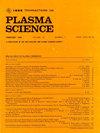利用低密度辉光放电氢等离子体控制氧化石墨烯(GO)膜的还原
IF 1.3
4区 物理与天体物理
Q3 PHYSICS, FLUIDS & PLASMAS
引用次数: 0
摘要
在本工作中,通过氢等离子体处理化学制备的氧化石墨烯(GO)膜来生产还原性氧化石墨烯(rGO)。扫描电镜上表面图像显示氧化石墨烯的褶皱和分层片状结构,而氧化石墨烯的蚀刻表面更薄,片状更薄,皱巴巴的,类似纸的结构。从氧化石墨烯和还原氧化石墨烯薄膜的横截面图像可以发现,等离子体处理后,薄膜厚度明显减小。氧化石墨烯和还原氧化石墨烯的EDX分析证实了石墨烯片的成功还原。XRD谱图显示,在$2\theta = 11.21^{\circ }$处有一个宽衍射峰,对应于氧化石墨烯的层间距7.9Å和晶格面(001)。相比之下,等离子体处理后,峰值明显降低并移至$2\theta = 11.82^{\circ }$,对应于层间距7.5Å。原子力显微镜(AFM)分析表明,与未经处理的氧化石墨烯相比,还原氧化石墨烯的表面粗糙度有所增加。x射线光电子能谱(XPS)和傅里叶变换红外光谱(FTIR)分析证实,与原始氧化石墨烯相比,还原氧化石墨烯的不同氧官能团减少。氧化石墨烯的拉曼光谱在$\approx\! 1353.07$ cm−1和$\approx\! 1586.82$ cm−1处有两个突出的峰,分别为D波段和G波段,而氧化石墨烯的拉曼光谱在$\approx\! 1354.88$和1593.96 cm−1处分别有D和G波段的峰。rGO的${I} _{D}$ / ${I} _{G}$比值增加(9%) after the hydrogen plasma treatment implies that a limited amount of damage has occurred which causes the relative disorder. There is also a prominent improvement in the electrical properties of the rGO as compared with GO, which suggests that the plasma reduction approach is a very efficient technique for rGO preparation with higher conductivity.本文章由计算机程序翻译,如有差异,请以英文原文为准。
Controlled Reduction of Graphene Oxide (GO) Film Using Low-Density Glow Discharge Hydrogen Plasma
In the present work, reduced graphene oxide (rGO) is produced through hydrogen plasma treatment of chemically prepared graphene oxide (GO) film. The SEM top surface images show the wrinkled and layered flake structures for GO whereas a more etched surface with thinner sheets and a wrinkled, paper-like structure for rGO. From cross-sectional images of the GO and rGO films, it is found that the film thickness is reduced prominently after plasma treatment. The EDX analysis of GO and rGO confirms the successful reduction of graphene sheets. The XRD pattern shows a wide diffraction peak at $2\theta = 11.21^{\circ }$ corresponding to an interlayer spacing of 7.9Å and lattice plane (001) for GO. In contrast, the peak is prominently decreased and shifted to $2\theta = 11.82^{\circ }$ corresponding to an interlayer spacing of 7.5Å after the plasma treatment. The atomic force microscopy (AFM) analysis shows that the increase in surface roughness of rGO in comparison with untreated GO. X-ray photoelectron spectroscopy (XPS) and Fourier transform infrared (FTIR) spectroscopy analysis confirm the reduction of different oxygen functionalities for rGO in comparison with pristine GO. The Raman spectrum of GO displays two prominent peaks designated as the D band at $\approx\! 1353.07$ cm−1 and the G band at $\approx\! 1586.82$ cm−1, whereas, for rGO, the peaks for D and G bands are observed at $\approx\! 1354.88$ and 1593.96 cm−1, respectively. The ${I} _{D}$ / ${I} _{G}$ ratio increased for rGO (~9%) after the hydrogen plasma treatment implies that a limited amount of damage has occurred which causes the relative disorder. There is also a prominent improvement in the electrical properties of the rGO as compared with GO, which suggests that the plasma reduction approach is a very efficient technique for rGO preparation with higher conductivity.
求助全文
通过发布文献求助,成功后即可免费获取论文全文。
去求助
来源期刊

IEEE Transactions on Plasma Science
物理-物理:流体与等离子体
CiteScore
3.00
自引率
20.00%
发文量
538
审稿时长
3.8 months
期刊介绍:
The scope covers all aspects of the theory and application of plasma science. It includes the following areas: magnetohydrodynamics; thermionics and plasma diodes; basic plasma phenomena; gaseous electronics; microwave/plasma interaction; electron, ion, and plasma sources; space plasmas; intense electron and ion beams; laser-plasma interactions; plasma diagnostics; plasma chemistry and processing; solid-state plasmas; plasma heating; plasma for controlled fusion research; high energy density plasmas; industrial/commercial applications of plasma physics; plasma waves and instabilities; and high power microwave and submillimeter wave generation.
 求助内容:
求助内容: 应助结果提醒方式:
应助结果提醒方式:


